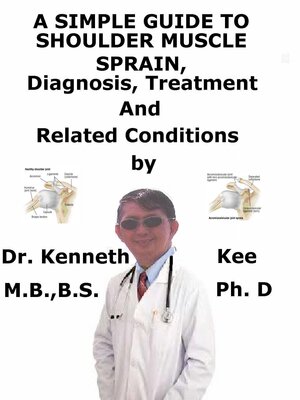A Simple Guide to Shoulder Muscle Sprain, Diagnosis, Treatment and Related Conditions
ebook
By Kenneth Kee

Sign up to save your library
With an OverDrive account, you can save your favorite libraries for at-a-glance information about availability. Find out more about OverDrive accounts.
Find this title in Libby, the library reading app by OverDrive.



Search for a digital library with this title
Title found at these libraries:
| Library Name | Distance |
|---|---|
| Loading... |
This book describes Shoulder Muscle Sprain, Diagnosis and Treatment and Related Diseases
Recently an old lady consulted me about the pain in her right shoulder which she sustained after a fall 2 months ago.
She had seen the hospital specialist who had her shoulder X-rayed and found no bony abnormalities such as fracture, dislocations or osteoarthritis.
The shoulder pain was worse at the deltoid muscle area and the movements of the right shoulder were affected.
It was worse at night especially sleeping on her right side because the shoulder was being pressed against the bed.
She had been given pain killers and muscle relaxant without improvement.
She had been treated by a Chinese physician with acupunctures and heat therapy without improvement.
On examination her right shoulder appeared normal except for tenderness at the lower part of the deltoid muscle and supra-scapular area of the shoulder blade.
Movement of the right shoulder forwards and backwards was normal.
Movement of the right shoulder upwards and downwards was limited to 90 degrees.
There is restriction of movement of the right shoulder when performing the hand to shoulder blade test.
There appeared to be a tear of the ligaments of the right shoulder and possibly the deltoid and supraspinatus muscles.
She had a right shoulder sprain after the fall and possible micro-tears of the deltoid and supraspinatus muscles.
The treatment involved painkiller such as brufen, shoulder brace and cold therapy followed by physiotherapy.
If the shoulder does not improve she may require a MRI to assess the tears in the ligaments and muscles and possibly surgical repair of the muscles.
A Shoulder Sprain happens from a tear of the ligaments which attach muscles to bone around the shoulder joint.
The tear in the ligaments may lead to pain and reduced range of motion of the shoulders.
There is a belief that the shoulder joint is a single joint between the humerus and the body but actually the shoulder comprises several smaller joints sited outside of the arm's socket.
The shoulder ligaments connect 4 bones, vital to smooth functioning of the shoulder.
The triangular shoulder blade or scapula
The bony knob at the top of the scapula or acromion
The collarbone or clavicle
The breastbone or sternum
A sprain that tears ligaments in the shoulder most often happens at the joint between the acromion and collarbone, termed the acromioclavicular joint.
Less often, a shoulder sprain involves the joint between the breastbone and collarbone, termed the sternoclavicular joint.
Normally a shoulder sprain can happen when backward force is placed on the arm and overstretches the shoulder ligaments.
This forceful movement produces the tearing of ligaments of the shoulder joint.
Other causes are:
Direct fall on the shoulder
Falling on the outstretched arm
Getting hit hard on the shoulder
Forceful twisting of the arm
Overuse or repetitive movement of the shoulder, such as in swimming or tennis
Sports injuries affecting the shoulder
Blow to the shoulder blade
Car accidents
A shoulder sprain is due to the rupture or stretching of the ligaments while a shoulder strain is caused by the overstretching or tear of the tendon or muscle.
Most shoulder sprains can be treated with non-surgical treatments such as Rest
Ice
Compression with a brace
Elevation of shoulder with a sling
Surgery can be indicated if pain continues or the deformity is obvious and affecting function.
TABLE OF CONTENT
Introduction
Chapter 1 Shoulder Muscle Sprain







